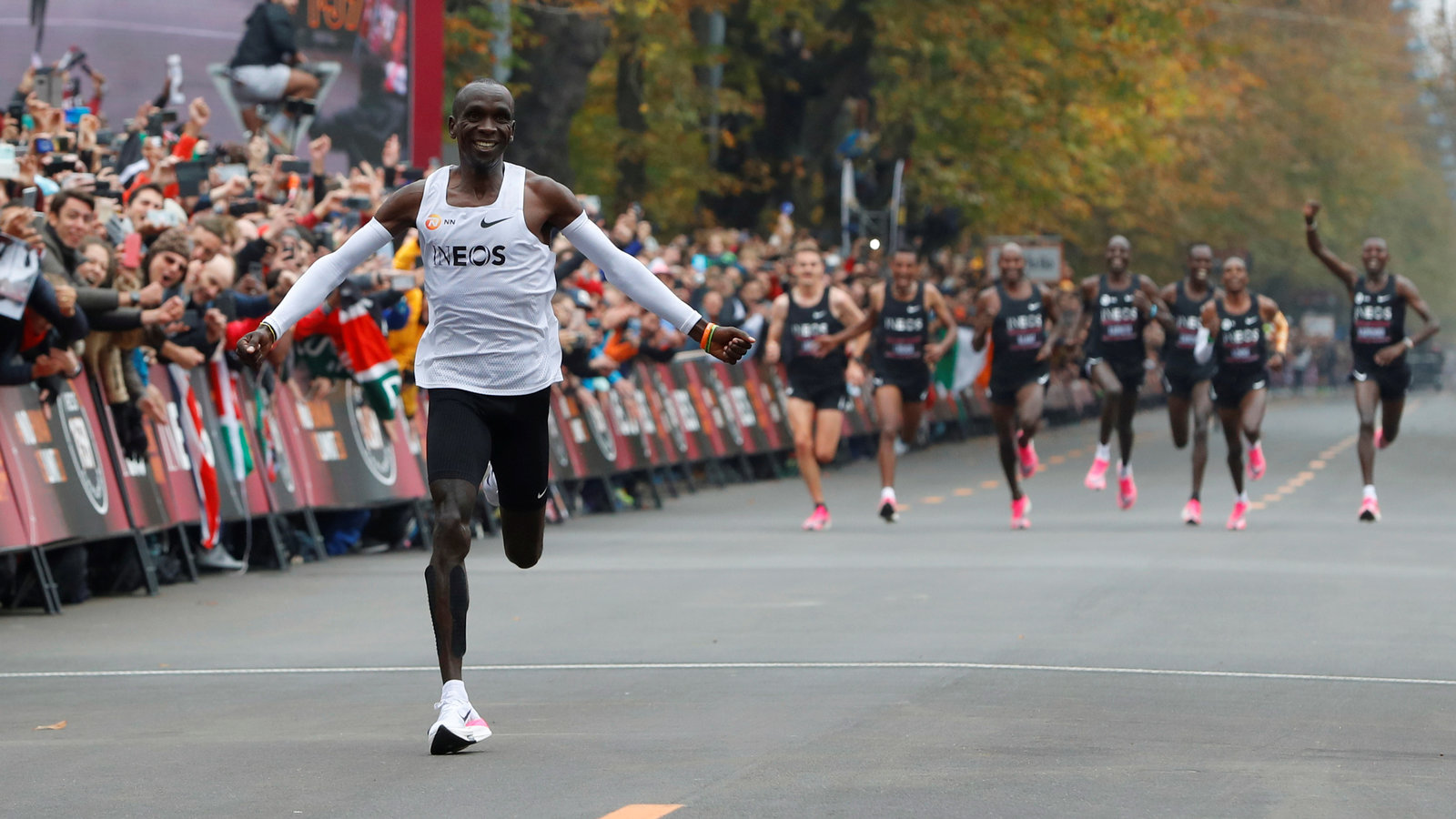

Featured
How To Run Faster In Ultramarathon
Modified: January 22, 2024
Featured: Learn how to run faster in ultramarathons with these expert tips and techniques. Enhance your endurance and achieve your personal best!
Introduction
In the exhilarating world of ultramarathons, where athletes push their physical and mental limits over extraordinary distances, speed plays a vital role. Running faster in an ultramarathon not only helps you achieve your personal best but also improves your overall performance and endurance. However, it takes more than sheer willpower to increase your pace in these grueling races.
Whether you’re a seasoned ultrarunner or a beginner looking to tackle your first race, this article will provide you with valuable insights and tips on how to run faster in ultramarathons. From proper warm-up and stretching techniques to interval training and strength workouts, we will explore various strategies that can help you boost your speed and improve your performance.
Running faster in ultramarathons requires a multifaceted approach that encompasses physical conditioning, proper technique, mental strategies, and effective nutrition and recovery practices. By implementing these strategies and making them a part of your training routine, you can enhance your speed and efficiency, ultimately contributing to a more successful and enjoyable race experience.
It’s important to note that improving your speed in ultramarathons is not solely about winning or competing against others. It’s about challenging yourself, pushing your limits, and continuously striving for personal growth and achievements. The journey towards becoming a faster ultrarunner is as rewarding as crossing the finish line.
So, whether you’re aiming to shave off seconds from your personal best or aiming to complete an ultramarathon within a specific time frame, this article will provide you with the tools and knowledge to enhance your speed, improve your running performance, and ultimately help you achieve your goals.
Importance of Speed in Ultramarathons
When it comes to ultramarathons, the focus is often on endurance and the ability to cover long distances. However, speed plays a crucial role in these races, and improving your pace can have a significant impact on your overall performance. Here are a few reasons why speed is important in ultramarathons:
- Efficient use of energy: Running at a faster pace allows you to cover more ground in less time, which means you can conserve energy for the later stages of the race. This efficiency is especially critical in ultra distances where fatigue can accumulate and hinder your performance.
- Competitive edge: If you’re aiming to compete with other runners and achieve a top position, speed becomes paramount. In ultramarathons, where races can be tightly contested, having the ability to maintain a faster pace can give you an edge over your competitors.
- Time management: Ultramarathons often have cutoff times at various checkpoints or finish lines. By improving your speed, you can ensure that you reach these checkpoints within the allotted time, avoiding disqualification and allowing you to complete the race.
- Mental resilience: Running at a faster pace requires mental toughness and discipline. By pushing your limits and training for speed, you can develop the mental resilience needed to overcome challenges during the race.
- Overall performance improvement: Speed training not only improves your pace but also enhances your overall running performance. By training for speed, you work on strengthening your muscles, improving your cardiovascular endurance, and refining your running technique, all of which contribute to better performance in ultramarathons.
While speed is important, it’s essential to find the right balance between speed and endurance. Ultramarathons are often about pacing yourself and managing your energy levels over long distances. Therefore, focusing solely on speed without considering the endurance aspect can lead to burnout or early fatigue.
Ultimately, improving your speed in ultramarathons should be viewed as a complement to your overall training and race strategy. It’s about finding the right balance between speed, endurance, and proper pacing to achieve optimal results in these demanding and extraordinary races.
Proper Warm-up and Stretching
Before diving into an intense ultramarathon, it is crucial to adequately warm up your body and engage in proper stretching routines. A comprehensive warm-up not only prepares your muscles for the physical demands of the race but also helps to prevent injuries and optimize performance. Here are some essential warm-up and stretching techniques to consider:
- Dynamic Warm-up: Start your warm-up routine with dynamic exercises that mimic the movements involved in running. Include exercises such as jogging or brisk walking, leg swings, high knees, butt kicks, and lunge walks. These movements increase blood flow to the muscles, raise body temperature, and activate the muscle groups needed for running.
- Stretching: While static stretching holds less significance during the warm-up phase, light stretching can still be beneficial. Focus on dynamic stretches that involve movement and mimic the motions of running. This can include leg swings, walking lunges, and knee-to-chest raises. These stretches help to improve flexibility, increase range of motion, and warm up the muscles gradually.
- Activation Exercises: Incorporate exercises that target the specific muscles and areas prone to injury or weakness in ultrarunning. This can include exercises like lunges with a twist to activate the core, glute bridges to engage the glute muscles, and calf raises to activate the calves. Activating these muscles helps to improve muscle recruitment and stability during running.
- Joint Mobility Exercises: Include exercises that promote joint mobility and range of motion. This can involve ankle circles, wrist circles, shoulder rolls, and neck rotations. Focusing on joint mobility helps to enhance running mechanics and reduce the risk of injuries.
Remember, the warm-up should be dynamic, gradually increasing in intensity, and tailored to your specific needs and comfort level. Pay attention to your body and adjust the warm-up duration and exercises based on personal preference and the weather conditions.
Additionally, it’s essential to note that warming up is not a one-size-fits-all approach. Different runners may require different warm-up routines based on their individual needs, preferences, and any pre-existing injuries or conditions. Experiment with various warm-up techniques during your training to find what works best for you.
Incorporating a proper warm-up and stretching routine into your ultramarathon preparation will help to minimize the risk of injury, enhance muscle performance and activation, and optimize your overall running experience. Make it a habit to dedicate time to warm up before each training session and race, and you’ll notice the positive impact on your speed, endurance, and overall performance.
Building Endurance through Long Runs
Building endurance is essential for success in ultramarathons, as these races often require hours or even days of continuous running. Long runs play a crucial role in developing the endurance necessary to conquer the challenges of ultra distances. Here’s how you can effectively build endurance through long runs:
- Gradual Progression: Start by gradually increasing the distance of your long runs over time. Begin with distances that challenge you but are still manageable, and then progressively increase the mileage as your body adapts. Aim to add an additional mile or two to your long runs every few weeks, allowing your cardiovascular system and muscles to gradually adapt to longer distances.
- Slow and Steady: Long runs are not about speed; they are about building endurance. Focus on maintaining a comfortable and steady pace throughout your long runs. Your goal is to cover the distance, not to set a personal record in terms of speed. Starting too fast can lead to early fatigue and hinder your ability to complete the full distance.
- Nutrition and Hydration: Proper nutrition and hydration are vital during long runs to sustain energy levels and maintain performance. Practice fueling strategies during your training runs, experimenting with different types of energy gels, hydration packs, or electrolyte drinks. It’s crucial to understand your body’s requirements for fluid and energy intake during long runs to avoid dehydration and bonking, which can significantly impact your endurance.
- Mental Training: Long runs are not just physical challenges; they also test your mental endurance. Use these runs as an opportunity to practice mental resilience and coping strategies. Break the distance into manageable segments and stay mentally focused and positive throughout the run. Visualization techniques, positive affirmations, and distraction techniques can all help to keep your mind engaged and motivated during the long runs.
- Tapering: Incorporate taper periods into your training schedule before your big ultramarathon events. Tapering involves gradually reducing your training volume and intensity in the weeks leading up to the race. This allows your body to recover, replenish energy stores, and optimize performance for race day.
Remember, consistency is key when it comes to building endurance through long runs. Plan your long runs strategically, incorporating them into your training schedule at regular intervals. Each long run serves as a building block, gradually increasing your stamina and preparing you for the physical and mental demands of ultramarathons.
It’s important to listen to your body during long runs and adjust your pace or distance if necessary. Be patient with the process, as building endurance takes time and requires dedication. Embrace the journey and celebrate your progress along the way, knowing that each long run brings you closer to becoming a stronger and more resilient ultrarunner.
Incorporating Interval Training
Interval training is a powerful tool that can help you improve your speed, endurance, and overall performance in ultramarathons. By alternating between high-intensity bursts of speed and recovery periods, interval training pushes your limits and helps you build aerobic capacity and anaerobic power. Here’s how you can effectively incorporate interval training into your training regimen:
- Select Appropriate Intervals: Choose interval distances or durations that align with your current fitness level and race goals. Shorter intervals, such as 400 meters or 1 minute bursts of speed, can focus on developing speed and anaerobic power. Longer intervals, such as 800 meters or 2-3 minutes, help to improve aerobic capacity. Experiment with various interval lengths and intensities to challenge your body and prevent plateauing.
- Warm-up and Cool Down: Begin each interval training session with a thorough warm-up to prepare your muscles and joints for the intense effort. Include dynamic exercises, light jogging, and strides to raise your heart rate and increase blood flow to your working muscles. After completing the intervals, engage in a cool-down that includes easy jogging and static stretching to aid recovery and promote flexibility.
- Vary Intensity and Effort: Intervals are all about pushing your limits, so make sure to vary the intensity of each interval session. Challenge yourself by working at a high intensity during the speed intervals, aiming to maintain a pace slightly faster than your race pace. Ensure that you have adequate recovery periods between intervals to allow your heart rate to drop and your body to recover.
- Mix Up Interval Types: Incorporating different types of intervals adds variety to your training and targets different energy systems. Besides traditional speed intervals, you can try tempo intervals, fartlek runs, hill repeats, or ladder intervals. This variety helps to prevent boredom, stimulate different muscle groups, and improve your overall running economy.
- Progress Gradually: Start with a manageable number of intervals and gradually increase the volume and intensity as your fitness improves. Avoid jumping into high-intensity interval training too quickly, as it can increase the risk of injury or burnout. Allow your body time to adapt and recover between training sessions.
Integrate interval training into your training schedule once or twice a week, depending on your goals and fitness level. Balance interval training with other types of runs, such as long runs and easy recovery runs, to ensure a well-rounded training plan.
Remember, interval training is physically demanding, so it’s important to listen to your body and give yourself adequate rest and recovery days. As you progress in your interval training, you’ll notice improvements in your speed, endurance, and overall performance, enabling you to tackle the challenges of ultramarathons with confidence and strength.
Strength Training for Speed and Power
Strength training is not just for bodybuilders or sprinters; it is also highly beneficial for ultramarathon runners. Incorporating strength training into your training regimen can help improve your speed, power, and overall running performance. Here’s how you can effectively incorporate strength training into your routine:
- Focus on Core Strength: A strong core is essential for maintaining proper running form, stability, and balance. Include exercises that target your core muscles, such as planks, Russian twists, and bicycle crunches. Additionally, integrate exercises that engage your hip flexors, glutes, and lower back, as these muscles play a vital role in generating power and maintaining a strong and efficient running stride.
- Incorporate Full-Body Exercises: Don’t just focus on isolated muscle groups. Incorporate full-body exercises, such as squats, lunges, deadlifts, and step-ups, to improve overall strength and stability. These exercises engage multiple muscle groups simultaneously and help develop strength and power throughout your entire body, enhancing your running performance in the process.
- Include Plyometric Exercises: Plyometric exercises involve explosive movements that improve power and speed. Incorporate exercises like box jumps, jump squats, and depth jumps into your training routine. Plyometrics help train your muscles to generate force quickly, which can be particularly beneficial for uphill sections or sprint finishes in ultramarathons.
- Train Eccentric Movements: Eccentric muscle contractions occur when a muscle lengthens under tension. Incorporate eccentric exercises, such as eccentric squats or downhill running, into your strength training routine. These exercises help condition your muscles to handle the impact and stress of downhill sections commonly encountered in ultramarathons.
- Don’t Forget about Upper Body Strength: While running primarily involves the lower body, neglecting upper body strength can lead to imbalances and poor overall posture. Include exercises that target your chest, back, shoulders, and arms, such as push-ups, pull-ups, and overhead presses. A strong upper body helps in maintaining proper running form and endurance, especially during longer races.
When incorporating strength training, aim for 2-3 sessions per week. Start with lighter weights or bodyweight exercises and gradually increase the resistance as you build strength. Remember to maintain proper form and technique throughout each exercise and listen to your body to prevent overexertion or injury.
Strength training should be done in conjunction with your running workouts. Allow for adequate rest and recovery between strength training sessions and running sessions to avoid overtraining. It’s essential to strike a balance between strength training and running, as both are crucial components of your ultramarathon training program.
By incorporating strength training into your routine, you’ll improve your speed, power, and overall performance as an ultramarathon runner. Regular strength training not only enhances your running efficiency and endurance but also helps prevent injuries and promotes long-term running success.
Technique and Form Improvements
Improving your running technique and form is crucial for maximizing efficiency, preventing injuries, and ultimately running faster in ultramarathons. Making small adjustments to your posture, stride, and footwork can have a significant impact on your overall performance. Here are some key areas to focus on when working on your technique and form:
- Posture: Maintain an upright posture while running, with your head aligned with your spine and your shoulders relaxed. Avoid slouching or leaning forward, as it can lead to inefficient movement and unnecessary strain on your body. Engaging your core muscles helps maintain proper posture throughout your runs.
- Foot strike: Focus on landing midfoot or forefoot when your foot strikes the ground, instead of striking with your heel. This promotes better shock absorption and reduces the risk of injuries such as shin splints or stress fractures. Practicing a light and quick turnover helps improve foot strike efficiency.
- Stride length and cadence: Aim for a stride length that feels comfortable and natural to you. Avoid overstriding, which can lead to braking forces and inefficient movement. Instead, focus on increasing your cadence, the number of steps you take per minute. A higher cadence helps reduce ground contact time and promotes a more efficient running stride.
- Arms and Upper Body: Keep your arms relaxed and at a 90-degree angle, swinging them back and forth in a natural motion. Avoid crossing your arms over your body or excessive arm movement that wastes energy. A controlled and coordinated arm swing helps maintain balance and forward momentum while running.
- Breathing: Practice diaphragmatic breathing, inhaling deeply into your abdomen and exhaling fully. This allows for more efficient oxygen exchange and helps you maintain a steady rhythm while running. Avoid shallow chest breathing, as it can lead to muscle tension and decreased oxygen intake.
Improving your technique and form takes time and practice. Start by focusing on one aspect at a time during your training runs. Gradually incorporate drills and exercises, such as form drills or stride workouts, that specifically target the areas you want to improve.
It can also be helpful to record yourself running or work with a running coach to get feedback on your technique. Having visual feedback can allow you to identify areas that need improvement and make the necessary adjustments accordingly.
Remember, technique and form improvements are a continuous process. Regularly assess and refine your running technique, incorporating feedback and making adjustments as needed. With consistent practice, you’ll develop more efficient movement patterns, reduce the risk of injuries, and ultimately enhance your speed and performance in ultramarathons.
Mental Strategies for Running Faster
Running faster in ultramarathons not only requires physical strength and endurance but also mental resilience and strategies to push through challenges. Developing a strong mindset and employing effective mental strategies can help you maintain focus, manage fatigue, and push your limits. Here are some mental strategies that can help you run faster in ultramarathons:
- Goal Setting: Set clear and attainable goals for each race or training session. Having a specific target in mind helps motivate you to push harder and gives you a sense of purpose during your runs. Break your goals down into smaller milestones, such as reaching a certain distance or maintaining a certain pace. Celebrating these smaller achievements can provide positive reinforcement along the way.
- Positive Self-Talk: Utilize positive self-talk to keep your mindset focused and motivated during runs. Replace negative thoughts or doubts with positive affirmations and encouragement. Repeat mantras that resonate with you, such as “I am strong” or “I can do this.” Cultivating a positive inner dialogue can help you overcome mental barriers and maintain a determined mindset.
- Visualization: Use the power of visualization to mentally rehearse your races or challenging sections of your ultramarathons. Create vivid images in your mind of successfully completing a challenging hill or crossing the finish line strong and confident. Visualizing success helps build confidence, reduces nervousness, and primes your mind and body for a strong performance.
- Break the Race into Smaller Segments: Mental fatigue can be overwhelming during long-distance races. Break the race down into smaller, manageable segments, focusing on one milestone at a time. Conquer each segment before moving on to the next, and mentally reward yourself as you reach each milestone. This approach helps prevent feeling overwhelmed and gives you a sense of progress and accomplishment throughout the race.
- Mindfulness and Focus: Practice mindfulness techniques during your runs to stay present and focused. Instead of getting caught up in negative thoughts or distractions, consciously direct your attention to your breath, your form, or the surroundings. Stay in tune with your body and embrace the sensations, rather than letting your mind wander or dwell on negativity.
Remember, mental strategies require practice to become effective. Incorporate these techniques into both your training runs and races to build mental strength and resilience over time. As with physical training, consistent mental training is key to unlocking your full potential as an ultramarathon runner.
It’s important to approach these mental strategies with an open mind and find what works best for you. Experiment with different techniques and adapt them to fit your unique personality and preferences.
By mastering mental strategies and developing a strong mindset, you can push through the physical and mental barriers that arise in ultramarathons. Running faster becomes not only about physical ability but also about the mental fortitude to overcome challenges and reach new levels of performance.
Nutrition and Hydration for Performance
Proper nutrition and hydration are key components of running faster and performing at your best in ultramarathons. Fueling your body with the right nutrients and maintaining adequate hydration levels can help optimize your performance, enhance endurance, and prevent fatigue. Here are some important guidelines for nutrition and hydration during ultramarathons:
- Pre-Race Nutrition: Prior to an ultramarathon, focus on consuming a balanced meal that includes carbohydrates for energy, lean proteins for muscle repair, and healthy fats for sustained energy. Aim to eat a meal that you are familiar with and that works well for you, typically 2-3 hours before the start of the race. Additionally, avoid trying new foods or supplements on race day to prevent gastrointestinal distress.
- During-Race Nutrition: During long-distance races, it is crucial to fuel your body with easily digestible carbohydrates and electrolytes. Consume carbohydrates in the form of energy gels, chews, or sports drinks at regular intervals to maintain glycogen levels and provide a steady source of energy. Listen to your body, follow a plan based on your training and experience, and adjust your nutrition intake or timing as needed. Make sure to hydrate adequately by sipping small amounts of fluids consistently throughout the race.
- Hydration: Hydration is key to maintaining performance and preventing dehydration during ultramarathons. Develop a hydration plan that suits your needs and race conditions. Opt for a combination of water and electrolyte beverages to replace fluids and replenish electrolytes lost through sweat. Monitor your fluid intake and adjust it based on factors such as weather conditions, sweat rate, and individual tolerance. As a general guideline, aim to drink enough to stay hydrated without drinking excessively and causing discomfort.
- Post-Race Recovery: After an ultramarathon, prioritize post-race recovery by consuming a mix of carbohydrates and protein within 30-60 minutes. This helps replenish glycogen stores, repair muscle damage, and kickstart the recovery process. Include nutrient-dense foods such as fruits, vegetables, lean proteins, and whole grains in your post-race meals to support recovery and replenish essential nutrients.
- Practice and Experiment: It’s essential to practice your nutrition and hydration strategies during training runs to identify what works best for you and avoid any digestive issues on race day. Experiment with different types of energy gels, sports drinks, and other fuel sources to determine what your body tolerates well and what provides optimal performance for you.
Keep in mind that nutrition and hydration needs can vary among individuals, so it’s important to tailor your approach based on your body’s requirements, race conditions, and personal preferences. Regularly monitor your energy levels, hydration status, and adjust your nutrition and hydration plan accordingly.
Lastly, seek advice from a registered dietitian or sports nutritionist to develop a personalized nutrition and hydration strategy that caters to your specific needs and goals as an ultramarathon runner. They can provide valuable guidance and insights based on your individual requirements and help optimize your performance through targeted nutrition and hydration practices.
Recovery and Rest Days
Recovery and rest days are critical components of any training program, especially when it comes to running faster in ultramarathons. Giving your body time to heal, repair, and adapt to the physical demands of training is essential for maximizing performance and preventing injuries. Here are some key aspects to consider when incorporating recovery and rest days into your ultramarathon training:
- Physical Recovery: Allow your body time to recover from the stress and strain of intense training runs. This includes incorporating rest days into your training schedule, where you engage in light activities or complete rest. Rest days allow your muscles and connective tissues to repair, rebuild, and adapt, ultimately leading to improved strength and performance.
- Active Recovery: On rest days, consider engaging in light activities that promote blood flow and aid in recovery. Light stretching, foam rolling, yoga, or walking are excellent options for active recovery. These activities help reduce muscle stiffness, improve flexibility, and enhance overall recovery without adding excessive stress to the body.
- Sleep and Restorative Strategies: Prioritize getting adequate sleep to support proper recovery and regeneration. Sleep plays a crucial role in hormone regulation, tissue repair, and mental well-being. Aim for 7-9 hours of quality sleep each night and establish a consistent sleep routine. Additionally, explore other restorative strategies such as meditation, gentle massage, or relaxation techniques to promote relaxation and mental rejuvenation.
- Listen to Your Body: Pay attention to any signs of fatigue, soreness, or excessive physical or mental stress. If you’re feeling overly fatigued or experiencing pain, it’s important to allow for additional rest and recovery. Pushing through extreme fatigue or ignoring potential injuries can lead to further damage and hinder your progress in the long run.
- Cross-Training: Incorporate cross-training activities into your routine to vary the stress placed on your body. Engaging in activities such as swimming, cycling, or strength training on rest days can help maintain cardiovascular fitness, improve strength and stability, and provide a mental break from running.
Remember, recovery is not a passive process but an active part of your training program. Embrace rest days and recovery strategies as an essential part of the training process rather than viewing them as a hindrance to progress. Prioritizing recovery allows your body to adapt, strengthen, and perform at its best.
It’s important to strike a balance between training intensity and adequate recovery. Every runner’s recovery needs may vary, so listen to your body and adjust your training schedule as necessary. Consulting with a coach or trainer can provide valuable insights and guidance on optimizing your recovery and rest days specific to your training goals and needs.
By incorporating proper recovery and rest days into your ultramarathon training, you’ll enhance your overall performance, reduce the risk of overuse injuries, and ensure that you are physically and mentally prepared to run faster on race day.
Conclusion
Running faster in ultramarathons is a challenging yet rewarding journey that requires a combination of physical training, mental fortitude, and strategic approaches. By implementing the strategies outlined in this article, you can enhance your speed, improve your endurance, and perform at your best in these grueling races.
From proper warm-up and stretching techniques to building endurance through long runs, incorporating interval training, and focusing on strength and technique improvements, each aspect plays a crucial role in maximizing your speed and performance. Additionally, developing mental strategies, fueling your body with proper nutrition and hydration, and embracing recovery and rest days are essential components for success.
It’s important to remember that progress takes time and consistency. The key is to approach your training with dedication, listen to your body, and make adjustments as needed. Each training run and race presents an opportunity for growth, learning, and improvement.
As you embark on your journey to run faster in ultramarathons, embrace the challenges, celebrate the milestones, and stay motivated through the ups and downs. Remember that running faster is not just about the physical aspect but also about tapping into your mental strength, pushing your limits, and enjoying the process along the way.
So lace up your shoes, train smart, stay committed, and let your passion for running guide you towards achieving your goals. Embrace the thrill of running faster in ultramarathons and enjoy the incredible journey that awaits you on the trail.









